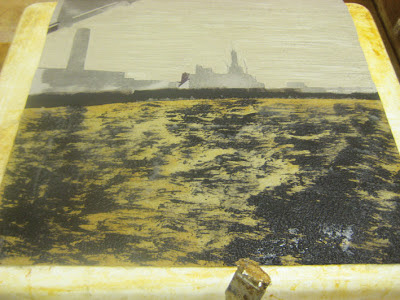Now for the caustic soda etch. The solution is very corrosive so it is important to wear protective gloves and goggles when mixing and applying. The caustic soda crystals and wallpaper paste can be bought at any hard wear shop. When you mix the solution, use a plastic container, not a metal one and try to be in a well ventilated room or even outside. I stir the solution with a wooden stick and use a nylon brush to apply it to the block. The etch recipe is:
Put 250 ml of water in the plastic container
Carefully add 3 tablespoons of caustic soda
Stir with the wooden stick/spoon until dissolved (this gives off a nasty fume, so be aware)
Add 1 tablespoon of wallpaper paste and carefully stir until absorbed into the mixture
Top left picture: Water/soda mix. Top right: It is useful to have a second plastic container with water to put your stick and brush in. Bottom: The solution eventually becomes gloopy after the wallpaper paste is added and mixed in (this takes about 4 – 5 mins).
Brush the paste onto the lino.
The first application sits on the surface and takes time to absorb into the areas of the block it can reach through the stop-out. After 1 hour, I re-apply a second coating of paste.
Again, after another hour, I apply a third coating. The paste is now sitting thickly on the surface of the block.
After 3 to 4 hours, it looks like this. The yellowing of the block indicates the caustic etch is working. Now at this point (depending on what effect you want) you can wash off the caustic etch with water and a scrubbier, using gloves. The option here is to see how deep the bite is, and perhaps repeat the whole process by reapplying a freshly mixed caustic solution.
Here is the cleaned block, drying on a hotplate.
Here is a close up after the first etch. I decide to do a second etch, re-mix some fresh caustic and repeat the application again. This time I will leave the caustic paste on overnight.




































